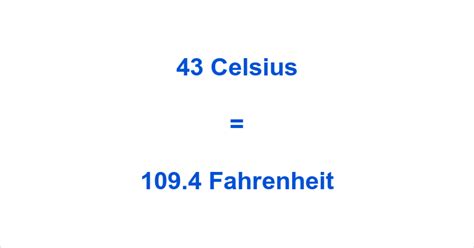43 Grados Centígrados Convertirlos A Fahrenheit
Kalali
Mar 31, 2025 · 4 min read

Table of Contents
Converting 43 Degrees Celsius to Fahrenheit: A Comprehensive Guide
The conversion between Celsius and Fahrenheit, two common temperature scales, is a frequently encountered task in various fields, from everyday life to scientific research. This comprehensive guide delves deep into converting 43 degrees Celsius to Fahrenheit, explaining the process step-by-step, providing context, and exploring related concepts.
Understanding Temperature Scales
Before diving into the conversion, let's briefly revisit the fundamental differences between Celsius (°C) and Fahrenheit (°F).
-
Celsius (°C): This scale, also known as the centigrade scale, is based on the freezing and boiling points of water at standard atmospheric pressure. 0°C represents the freezing point of water, and 100°C represents its boiling point. It's the most widely used temperature scale globally.
-
Fahrenheit (°F): This scale was developed by Daniel Gabriel Fahrenheit. The freezing point of water is 32°F, and the boiling point is 212°F. It's primarily used in the United States.
The Conversion Formula
The core of converting between Celsius and Fahrenheit lies in a simple, yet crucial, formula:
°F = (°C × 9/5) + 32
This formula tells us that to convert a Celsius temperature to Fahrenheit, we first multiply the Celsius value by 9/5 (or 1.8) and then add 32.
Converting 43°C to °F
Let's apply this formula to convert 43°C to Fahrenheit:
- Multiply by 9/5: 43°C × 9/5 = 77.4°
- Add 32: 77.4° + 32° = 109.4°F
Therefore, 43 degrees Celsius is equal to 109.4 degrees Fahrenheit.
Practical Applications and Significance
Understanding this conversion is critical in numerous situations:
-
Cooking and Baking: Recipes often specify temperatures in either Celsius or Fahrenheit. Accurate conversion ensures consistent results. A slight miscalculation can significantly alter the outcome of a dish.
-
Weather Forecasting: International weather reports frequently provide temperatures in Celsius, while many countries primarily use Fahrenheit. Understanding the conversion is essential for interpreting weather information from different sources.
-
Medicine and Healthcare: Body temperature, medication storage, and various medical procedures often require precise temperature control and readings, demanding accurate conversion between the two scales.
-
Science and Engineering: Across various scientific and engineering disciplines, accurate temperature measurements are paramount. Conversions are necessary for consistency and data interpretation in international collaborations and research.
-
Industrial Processes: Many industrial processes require precise temperature control, necessitating seamless conversions between Celsius and Fahrenheit to ensure optimal performance and safety.
Reverse Conversion: Fahrenheit to Celsius
It's equally important to understand the reverse conversion – changing Fahrenheit to Celsius. The formula for this is:
°C = (°F - 32) × 5/9
This formula involves subtracting 32 from the Fahrenheit value and then multiplying the result by 5/9.
Example: Converting 109.4°F to °C
Let's apply this formula to our previously converted value:
- Subtract 32: 109.4°F - 32°F = 77.4°
- Multiply by 5/9: 77.4° × 5/9 = 43°C
This confirms our initial conversion, demonstrating the accuracy of the formulas.
Beyond the Formula: Understanding the Underlying Concepts
While the formula provides a straightforward method for conversion, understanding the underlying principles enhances comprehension. The difference in the scales stems from the selection of reference points – the freezing and boiling points of water. Celsius uses a 100-degree interval between these points, while Fahrenheit uses a 180-degree interval. This difference accounts for the multiplicative factor of 9/5 (or 1.8) in the conversion formula. The addition of 32 accounts for the offset in the starting points of the two scales.
Advanced Applications and Considerations
-
Temperature Ranges: When working with temperature ranges, remember to convert both the upper and lower bounds of the range.
-
Significant Figures: Maintain the appropriate number of significant figures throughout your calculations to ensure accuracy.
-
Online Converters: Many online converters are available for quick and easy conversions between Celsius and Fahrenheit. While convenient, understanding the underlying formula is crucial for comprehensive understanding.
-
Different Units: Remember that temperature can be expressed in other units, such as Kelvin. Converting between different temperature scales often requires a multi-step process, possibly involving conversion to an intermediate scale like Kelvin.
Conclusion: Mastering Celsius to Fahrenheit Conversions
Mastering the conversion between Celsius and Fahrenheit is a valuable skill with numerous applications. This guide has provided a detailed explanation of the process, highlighting its practical significance across various fields. By understanding the formula, the underlying principles, and potential applications, you can confidently perform these conversions and interpret temperature information effectively. The ability to seamlessly convert between these scales enhances problem-solving capabilities and broadens understanding in various scientific, culinary, and everyday contexts. Remember that accuracy and attention to detail are paramount when dealing with temperature conversions, especially in situations where precise measurements are critical. Continued practice and application will solidify your understanding and make the process second nature.
Latest Posts
Latest Posts
-
What Is The Decimal For 9 5
Apr 02, 2025
-
How Many Cups In 33 Oz
Apr 02, 2025
-
What Is 3 10 As A Decimal
Apr 02, 2025
-
0 25 Mole Of Mg Contains How Many Atoms
Apr 02, 2025
-
5 Lb Is How Many Oz
Apr 02, 2025
Related Post
Thank you for visiting our website which covers about 43 Grados Centígrados Convertirlos A Fahrenheit . We hope the information provided has been useful to you. Feel free to contact us if you have any questions or need further assistance. See you next time and don't miss to bookmark.
